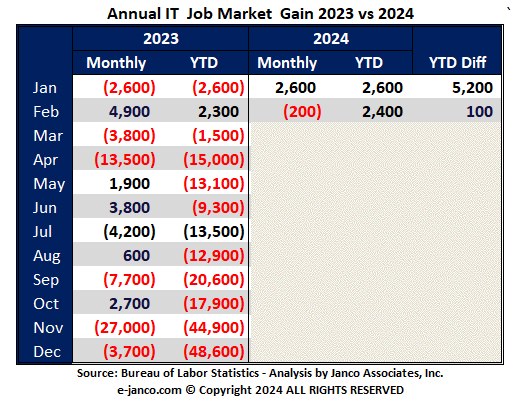 Software Developer Wages Fall Two Percent as Workforce Expands
Software Developer Wages Fall Two Percent as Workforce Expands
Wages fall even as the number of IT software development jobs expand
by Patrick Thibodeau
The U.S. tech industry added nearly 64,000 software related jobs last year, but as the workforce expanded, the average size of workers' pay checks declined by nearly 2%. There are multiple theories for the decline in pay, but a common one cited by analysts is simply that the new people being hired are paid less than those already on the job.
The average annual wage of all workers in the software services sector was $99,000 in 2012, about $2,000 less than the prior year, reported TechAmerica Foundation in its annual Cyberstates report. The foundation is an affiliate of the industry trade group TechAmerca. It uses Labor Dept. data to assemble its report.
Victor Janulaitis, CEO of Janco Associates, a research firm that also analyzes IT wage and employment trends, cited a number of reason for the decline in wages for software professionals. First, technology is becoming easier to implement without having an IT professional, he said. Also, the option of turning to outsourcing creates less pressure to increase wages.
IT Job Market Growth Lost 200 jobs last montt and YTD gained 2,400 jobs

Chart is based on the latest IT Job Market Analysis by Janco Associates.
Order Salary Survey Download Salary Survey Sample
As the recession continues, companies continue "to look at productivity and will often look to hire individuals who are lower cost employees," said Janulaitis. That could include displaced baby boomer workers who have been out of work for some time and "will take a lower paying job just to get back into the workforce."Matthew Kazmierczak, a senior vice president at TechAmerica, said if there is lots of hiring in an industry and the pay for new hires is below average, the average wage could go down. The hiring could be below the overall salary average "if many of the new jobs are more 'entry' level or people without the same specialized skills or years of experience (managerial or otherwise) as a more seasoned employee," said Kazmierczak.
"It is also possible that with the recession, wages [for new hires] dropped as more people were competing for jobs. So wages for new jobs are below average," said Kazmierczak. The Cyberstates report puts the tech labor force at 5.95 million in 2012, an increase of 1.1% from the prior year. Of that, 1.87 million workers are in software services jobs.
Software services, which includes government defined labor categories software publishers, custom programmers, computer facilities management and other computer related services, are the best paid and the largest segment of the tech work force.
The next largest, engineering and tech services, employs 1.62 million. Wages for workers in this segment increased by $1,500 to $92,500. But unlike software services, job growth was modest, increasing by only 11,300 last year.
David Foote, the CEO of Foote Associates, which analyzes IT hiring trends and wages, said the supply of workers in the software services segment "is plentiful. Of course, there are many unemployed workers who want to get back to work."
Employers, consequently, did not need to offer generous wage packages to fill many of their jobs. "In fact, [employers] could get workers pretty cheap," said Foote.
Foote said the IT industry-specific Cyberstates study doesn't include all tech workers. Working against the wage decline is high demand for certain software skill sets, which puts upward pay pressure on certain jobs that are harder to fill, he said.



